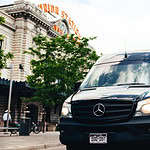
Passenger Vehicle Traction Law: One of the most important laws to remember is the Passenger Vehicle Traction Law, or Code 15, a little known law that is enacted when inclement weather hits I-70 to reduce the number of accidents and back-ups on the road. Those traveling on the highway will know when the law is being enforced via the variable message board signs along the interstate. Essentially, the law requires all cars traveling on I-70 to have either snow tires, tires with the mud/snow designation, or four-wheel drive vehicles. Additionally, all tires must have a minimum one-eighth inch tread. If you’re found not following any of these requirements, your fine could range from $130 to $650!

- Ice Scraper/Snow Brush: Stop by the nearest automotive parts store or gas station to pick up an ice scraper tool with an attached snow brush to help clean off your car.
- Jumper Cables: When it’s so cold out you don’t want to get up, your car battery probably doesn’t want to either. Have these handy to help yourself or someone else get back onto the road.
- Cat Litter, Salt, Sand, or Coffee Grounds: Store one of these in your trunk to provide helpful traction when stuck in snow. Scatter it underneath the area your tires will run over to help pull you out of a sticky situation.
- Shovel: A necessity when digging yourself out of a snowbank or if you’re arriving to a residence that hasn’t seen a shovel since the first snow storm hit the mountains.
- Sleeping Bag: It is not uncommon for I-70 and other smaller highways branching off to shut down because the roads are so terrible. When the roads get hairy and you have no choice but to stay where you are, have a sleeping bag in the car to slip into for a nap while you wait for the roads to clear.
- Snacks & Water: Remote areas are a stone’s throw from high altitude popular destinations such as Breckenridge, Vail, Beaver Creek, Copper Mountain, and Keystone. Be sure to bring something to help sustain you if you need to get your car unstuck or have to walk to find cell service. Don’t forget to keep yourself hydrated at such high elevations; always have water in your car.
- Flashlight & Batteries: Many of the mountain highways found in Colorado, including some sections of I-70, lack street lights so if you hit some ice or snow and your car goes off the road make sure you have a working flashlight. Don’t rely on your precious cell phone battery life to help get you out of a sticky situation. Have a back-up supply of batteries in your car as well in case your flashlight does go out.

- Brakes: When coming to a stop or slowing down avoid locking up your brakes by gently tapping on them.
- Slow your speed: The old saying “ice and snow, take it slow” is some of the best advice you can take while driving in inclement weather. Drive at a comfortable speed and avoid abrupt braking, accelerating, or steering.
- Be wary of roads: On a bluebird day when you’ve gotten your skis together and have fresh Colorado powder on the brain, the last thing you’re thinking about are road conditions. It’s a sunny day and the roads are plowed, so it seems safe to go faster than usual to make it to the resort for first chair, but be wary of roads that seem “clear” as there could very well be black ice, a clear type of ice that is nearly invisible on roads but is extremely slippery.
- Clean off snow and ice from the car: In order for you to get from point A to point B safely, you need to see clearly. Be sure to wipe all snow from your vehicle, including snow on your license plate and on the hood of your car (which can blow back onto the windshield while driving and turn into ice on your wipers) as well as ice build up on the windows inside and outside of your car.
- No tailing: Keep a safe distance from the car in front of you and a good rule of thumb is to give yourself four seconds from the car ahead of you in bad conditions. Keep in mind that coming to a complete stop in snow and ice takes a larger distance than on dry roads.
- Snow tires: If you’re driving in the wintertime, at the bare minimum your vehicle should have all-season tires. Splurging on snow tires can save you some unnecessary worrying but all-season tires can be adequate enough as long as you accommodate your driving for inclement weather.
Download the CDOT app to your phone: It is important that you educate yourself on road conditions and the forecasted weather for the days you are traveling. The Colorado Department of Transportation Mobile App contains helpful information for travelers driving on the I-70 and I-25 mountain corridors.



